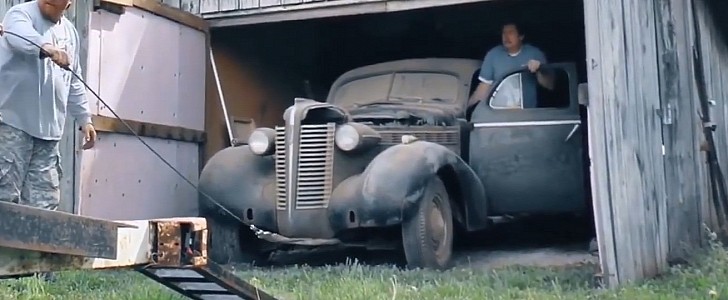Have you noticed how most barn finds are usually of the 1950s and 1960s variety nowadays? That's exactly what makes them somewhat mundane (unless we're talking about super-rare models, of course). 1930s cars, on the other hand, aren't very common.
Granted, pre-WW2 cars are also prone to rot away much quicker when they're stored away in inadequate conditions, but some manage to survive long enough to be rescued. This 1938 Buick was lucky enough to get a proper roof over its head and a solid floor under its wheels and took 30 years of sitting like a champ.
Discovered in a repair shop in the early 1990s this old Buick was a father-son project that was supposed to become a road-worthy classic. Unfortunately, though, the father passed away a few years back and the son stopped working on the car because of that. Three years later and he decided to let it go and the Buick saw daylight for the first time in three decades.
Surprisingly enough, the car appears to be in fantastic condition for a vehicle that's been off the road for so long. Sure, the paint has faded away, but the body panels are still straight and there's next to no visible rust on the outside. And while it may seem incomplete at first glance, the engine hood and the front bumper were also found in the barn.
But by far the coolest thing about this old Buick is that it still has its numbers-matching engine. And it's the company's rather iconic overhead valve inline-eight. Introduced in 1931 and marketed as the "Fireball Eight" and the "Dynaflash," this eight-cylinder mill soldiered on until 1953. And it powered every single Buick out there until it was replaced by the even more famous "Nailhead" V8.
Initially displacing 221 cubic inches (3.6 liters), the straight-eight grew to 320 cubic inches (5.2 liters) toward the end of its life cycle. This specific Buick features the 248-cubic-inch (4.1-liter) "Dynaflash" version, which Buick had introduced in 1937. It was rated at 107 horsepower and 203-pound-feet (275 Nm) of torque.
So what kind of Buick model are we looking at here? Well, the company was offering four different automobiles in 1938, but they all looked very similar. However, this one seems to have a short wheelbase, so we're probably looking at an entry-level Special model.
Buick also offered a fancied-up version with a larger engine called the Century and two longer-wheelbase variants with "Roadmaster" and "Limited" badges. The latter was the flagship model and it's the rarest with fewer than 1,500 built in 1938. For reference, Buick sold about 130,900 Specials that year, including almost 80,000 sedans like this one. But even though they made quite a few of them, you barely see any 1938 Buicks on the road nowadays. So this car is definitely worth restoring.
Discovered in a repair shop in the early 1990s this old Buick was a father-son project that was supposed to become a road-worthy classic. Unfortunately, though, the father passed away a few years back and the son stopped working on the car because of that. Three years later and he decided to let it go and the Buick saw daylight for the first time in three decades.
Surprisingly enough, the car appears to be in fantastic condition for a vehicle that's been off the road for so long. Sure, the paint has faded away, but the body panels are still straight and there's next to no visible rust on the outside. And while it may seem incomplete at first glance, the engine hood and the front bumper were also found in the barn.
But by far the coolest thing about this old Buick is that it still has its numbers-matching engine. And it's the company's rather iconic overhead valve inline-eight. Introduced in 1931 and marketed as the "Fireball Eight" and the "Dynaflash," this eight-cylinder mill soldiered on until 1953. And it powered every single Buick out there until it was replaced by the even more famous "Nailhead" V8.
Initially displacing 221 cubic inches (3.6 liters), the straight-eight grew to 320 cubic inches (5.2 liters) toward the end of its life cycle. This specific Buick features the 248-cubic-inch (4.1-liter) "Dynaflash" version, which Buick had introduced in 1937. It was rated at 107 horsepower and 203-pound-feet (275 Nm) of torque.
So what kind of Buick model are we looking at here? Well, the company was offering four different automobiles in 1938, but they all looked very similar. However, this one seems to have a short wheelbase, so we're probably looking at an entry-level Special model.
Buick also offered a fancied-up version with a larger engine called the Century and two longer-wheelbase variants with "Roadmaster" and "Limited" badges. The latter was the flagship model and it's the rarest with fewer than 1,500 built in 1938. For reference, Buick sold about 130,900 Specials that year, including almost 80,000 sedans like this one. But even though they made quite a few of them, you barely see any 1938 Buicks on the road nowadays. So this car is definitely worth restoring.








